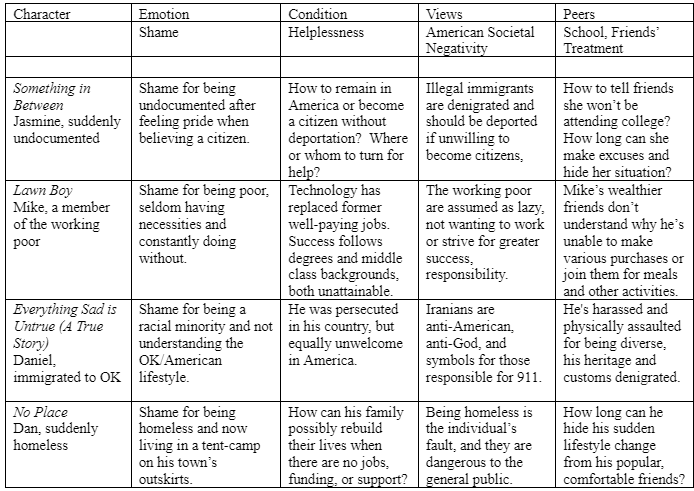The protagonists from the titles below represent being undocumented, the working poor, an immigrant, and homelessness. None of these conditions (several unexpected and shocking) are of the teens’ own doing, with all initially unequipped to handle them.
While these protagonists must find ways to cope and move forward, they also experience being an outsider, some for the first time, and now vilified by society, friends, teachers, and perhaps even themselves in the past. Many, like contemporary readers, judged and blamed quickly, having naïve views of situations and issues rather than understanding complexities and aware of individual circumstances. Still, these novels end with hope, their solutions ones readers with
similar issues could emulate.
Educators can assist all students, and those most vulnerable, by using or recommending YAL featuring characters in the above situations and others, along with providing accurate, non-biased information about them. Likewise, their classrooms should be safe for all students, regardless of situation, whether known, or not. Adolescents also need to learn, understand, and discuss these issues as well as others’ responses and views.
This discussion can be difficult, as some students may be experiencing these circumstances, others terrified of their probable appearance, and some contemptuous of them. By considering characters (rather than particular individuals) objectively in novels, their entire story can be heard, surely resulting in greater comprehension and compassion, along with providing hope and sense of commonality to those likewise vulnerable.
The following four novels depict vulnerable teens and were used for the activity below:
- de la Cruz, M. (2016). Something in between. Harlequin Teen.
- Evison, J. (2018). Lawn boy. Algonquin Books of Chapel Hill.
- Nayeri, D. (2020). Everything sad is untrue (A true story). Levine Querido.
- Strasser, T. (2014). No place. Simon & Schuster.
The following chart may be used to describe emotions/situations (many may be selected) experienced by these protagonists, which can be used for discussion of both individual treatments and comparing/connecting titles. Of course, a single novel could be examined or other combinations; students may enter multiple examples under each category, perhaps the three, or one, felt most important, etc., with its classroom talk surely perceptive and valuable. For space issues, table content is summarized, another format fitting whole class discussion.

She also serves and provides leadership for numerous NCTE assemblies, special interest groups, and committees, especially ELATE, and as an avid reviewer she regularly evaluates young adult literature novels and manuscripts for various journals and publishing houses.





 RSS Feed
RSS Feed